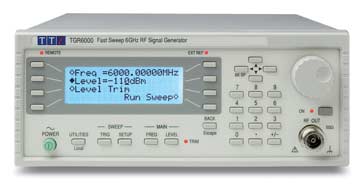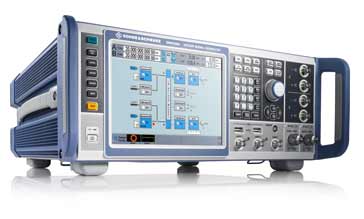Understanding RF signal generator specifications
The specifications for RF signal generators include frequency range, output power, phase noise, frequency accuracy, modulation types - these are all important in defining the generator operation.
Signal Generators includes:
RF signal generator basics
RF signal generator specs
Signal generator types: Signal Generator Basics Arbitrary waveform generator Function generator Pulse generator
As with any item of test instrumentation, the specification sheet sets out the performance of the particular RF signal generator.
The set of specifications used for RF signal generators is tailored towards the performance parameters that are of importance in that scenario. Parameters of specifications commonly used include the frequency range, output power levels, output power accuracy, harmonics and spurious signals and phase noise. These and a number of others are some of the parameters that are of prime importance.

There can be a significant difference in performance between the top end signal generators that can cost large amounts, when compared to lower end RF signal generators that can be afforded on more modest budgets. It is necessary to work out what is needed, and what will be needed to enable the best option to be chosen. Obviously for home applications like amateur radio, the cost of some of the very top end equipment is not affordable and not required, whereas for a development lab there may be no option but to invest significant amounts of money.
Frequency range
One of the obvious key specifications for any radio frequency signal generator is the frequency range that it covers. Many signal generators today are able to operate well into the microwave region as this is an area of growing interest.
When choosing the band required for a signal generator it is necessary to consider all the testing that will be needed. The frequency coverage required for the signal generator may not be just that of the unit under test. For example, when testing radio receivers it is necessary to test their susceptibility to out of band signals at image and other frequencies. These may be will outside the operating frequency range of the unit under test, and the signal generator will need to accommodate these and any other requirements.
Harmonics and spurious signals
All signal generators produce some level of spurious signals. Harmonics are generally much higher as considerable effort is spent in reducing intermodulation and other non-harmonically related spurious signals.
levels of harmonics and spurious signals are normally quoted in terms of decibels relative to the carrier.
Often the harmonic levels are relatively high because the output is not filtered, but other spurious signals should be well down in level.
Signal generator power output
Another important signal generator specification is its power output. For most RF signal generators, the power output specification is defined in dBm, i.e. dB relative to one milliwatt.
| dBm to Power Level |
|
|---|---|
| Power level dBm |
Power level milliwatts |
| 0 | 1 |
| 3 | 2 |
| 10 | 10 | 13 | 20 |
| 20 | 100 |
| 23 | 200 |
Although different signal generators have different output levels, the most common maximum output level is +13 dBm, although whatever the exact maximum level is, it is normally in the range 10 to 100 milliwatts, i.e. 10 to 20 dBm.
Power accuracy - relative and absolute:
For many test scenarios it is necessary for the output of the signal generator to be accurately known. This is because the response of the unit under test is most likely to vary according to the signal generator level. In some circumstances it is likely that the response may be very sensitive to the signal generator level. As a result the signal generator level accuracy specification is of great importance.
There are two elements to the output level accuracy of the signal generator. This is as a result of the way that the output level is controlled. The output of a signal generator generally consists of an attenuator and this gives the ability to vary the output level. Prior to the output attenuator in the signal generator, there is an amplifier with a feedback loop which is used to maintain an accurate fixed level. The accuracy of the attenuator then provides the relative accuracy of the individual steps while the maintained level of the amplifier provides the absolute level accuracy.
Signal generator phase noise
One items that has to be noted on many signal generators these days is the level of phase noise that is produced. The importance arises because many signal generators are fall into the category of a synthesized signal generator. While a synthesized signal generator offers many advantages from exact frequency selection to stability, and high levels of programmability, the issue of phase noise can be a problem in some generators, and the phase noise spec needs to be carefully considered.
When making general noise measurements of a system, the phase noise of a signal generator used may affect the measurements. Accordingly it is necessary to know what can be tolerated.
The level of phase noise from a radio frequency signal generator will generally fall as the offset from the carrier increases. The actual levels may be given at several points in a specification, and sometimes a plot of the phase noise may be given.
Phase noise levels are measured in terms of dBc / Hz. This is the level of noise in a 1 Hertz bandwidth relative to the level of the carrier. As noise is not on a single frequency but distributed over the frequency range, the wider the measurement bandwidth, the more noise is seen. Accordingly it is necessary to specify a bandwidth and 1 Hertz is taken as the standard.

Accuracy - short and long term
The accuracy of an signal generator is often important. With most RF signal generators using frequency synthesizers, this means that the frequency accuracy is determined by the frequency standard used within the generator. Frequency standards have their accuracy defined with a number of different specifications and these have to be combined in the correct manner to give the overall "accuracy". All accuracy measurements are specified in terms of parts per million (PPM). However there are elements including temperature stability, line voltage stability, ageing (i.e. the steady drift with time over many months of the crystal within the reference standard, etc. These need to be added statistically to gain the overall "accuracy" for the radio frequency signal generator.
Modulation formats supported
In order that many tests can be undertaken by the signal generator, it is necessary in many instances that the signal can be modulated. In this way real signals can be more fully simulated and the required tests undertaken. Most signal generators have the ability to modulate signals in a variety of ways, some providing greater levels of flexibility than others. As a result it is necessary to check the signal generator specifications to ensure that it has the required capabilities.
Originally many signal generators had the capability to have amplitude modulation, AM , and frequency modulation, FM applied. However with radio and wireless systems using far more advanced forms of modulation, many signal generators have very comprehensive modulation capabilities. Some of these may be provided by the use of additional options. Today a variety of modulation formats may be available in a signal generator. These may include: various forms of phase shift keying, PSK (including BPSK, QPSK, 8PSK, etc) as well as other more complicated modulation formats including quadrature amplitude modulation, QAM (including 16 and 64 point QAM) need to be used. Other modulation types including CDMA and OFDM may also be available. It is necessary to ensure that the radio frequency signal generator being considered is able to offer the required modulation formats.
Test equipment calibration interval
The calibration interval for any item of test equipment is important, and this is the case for any signal generator, whether it is new or a used signal generator. Test equipment calibration can add a significant amount to the cost of ownership, so it is necessary to consider the calibration interval. For many signal generators the interval will be a year, but if higher degrees of accuracy of any of the signal generator specifications are needed, then shorter time intervals may be needed.
RF signal generators vary considerably in performance. Often the performance is reflected in the price, and in view of the technology used in RF signal generators, they are often not cheap. However when the performance required exceeds the budget then it is possible to look at second user equipment, or even equipment from some of the up and coming new suppliers, or those using USB based RF generators. Using trusted suppliers means the quality, performance and support will be guaranteed, but sometimes new manufacturers, or those supplying USB based equipment may be the most viable option.
 Written by Ian Poole .
Written by Ian Poole .
Experienced electronics engineer and author.
More Test Topics:
Data network analyzer
Digital Multimeter
Frequency counter
Oscilloscope
Signal generators
Spectrum analyzer
LCR meter
Dip meter, GDO
Logic analyzer
RF power meter
RF signal generator
Logic probe
PAT testing & testers
Time domain reflectometer
Vector network analyzer
PXI
GPIB
Boundary scan / JTAG
Data acquisition
Return to Test menu . . .



